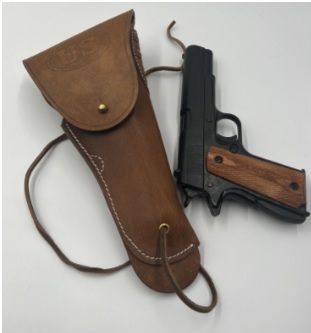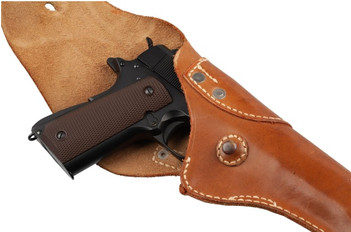Breaking in a Leather 1911 Holster
Jun 15th 2024
In the world of 1911 accessories, few offer the same class and elegance as a leather 1911 holster.
But in a world where you can get Kydex and nylon holsters that offer perfect fitment and retention pretty much from day one, it might seem like a 1911 leather holster is a lot of work.
It’s definitely more, but it’s worth it at the end of the day. Let’s cover the advantages of leather holsters and then get into break-in and maintenance.
An Argument in Favor of 1911 Leather Holsters
When you can get a cheap and serviceable Kydex or nylon 1911 holster, why would you want a leather 1911 holster?
well…
- Exceptional durability and flexibility
Kydex and nylon may be tough, but there’s nothing as strong - or as flexible - as full-grain leather that’s been properly broken in and conditioned. Try running over a Kydex or nylon and see where that gets you. Leather can handle it.
- They protect the gun
Many conventional leather 1911 holsters have a flap that completely (or mostly) encloses the gun, protecting it from rain, sun, wind, sand, and other environmental contaminants. Leather is also softer and supple, and can cushion the firearm better than other harder holster materials.
- They don’t “break’
Impacts and drops can crack or break nylon and Kydex holsters outright. That won’t happen with a leather 1911 holster!
- Comfort
There’s no way around it. Leather is softer and more comfortable to wear, especially directly against your body, than other conventional styles of holsters made from harder materials.
- The fit gets better over time
While Kydex and nylon can offer excellent primary retention and fit to the firearm from the first day, they will only get looser with time. As you break in leather and it forms exactly to the contours of your gun, the fit will actually improve over time.
- Heirloom quality and class
For better or worse, the cool factor of a leather 1911 holster is simply unmatched. There are few 1911 accessories with the same class and distinction as a fine leather holster, and if well-cared for, a leather holster represents a lifelong investment.
How to Break in a Leather 1911 Holster
With all of this said, breaking in a leather 1911 holster is going to take a bit of work. Here are some pointers.
Before doing any of this, make sure your firearm is unloaded.
- The best thing you can do to break in a leather 1911 holster is simply to use it. As you carry the gun holstered, the leather fibers will relax and shape to the contours of the gun.
- A good practice is to insert the gun snugly into the holster, as tightly down as it will fit, and leave it there when you are not carrying, to accelerate the break-in period. Don’t leave the gun in the holster for more than a few days without letting it breathe, though, as leather can trap moisture and can actually accelerate rust.
- If you have an older-style holster, such as an old 20th century military holster, you may also want to soften the leather with saddle soap or neatsfoot oil to make it easier to holster and draw the pistol.
- One technique is to insert the gun into a plastic bag and press it fully down into the holster, closing the flap securely. Place the gun somewhere cool and dry (away from a heat source) for several days and it will improve the fitment of the holster and also accelerate the break-in period.
Some people soak their holsters in water or even run over them with vehicles to soften the leather and make it easier to work - we do not suggest doing any of these as they can actually do more harm than good.

Periodic Care and Conditioning of a 1911 Leather Holster
Long after your 1911 leather holster is well worn and broken in, you will still need to administer periodic leather care to prevent the holster from getting brittle and cracking. Here are some general pointers.
- Caring for exterior leather: Exterior holster leather is usually thicker and tougher than interior leather, so stiffness is sometimes more important for keeping its shape. We recommend a leather polish like Kiwi polish to help maintain the finish and appearance of exterior holster leather. Either match the color of the polish to the leather or if you are unsure, choose a neutral color. Polish will also soften the leather slightly over time. You can also use neatsfoot oil or Fiebing’s leather conditioner on external holster leather, but be very sparing’ neatsfoot will soften leather, can change the color, and can come off on your clothing where the holster contacts it. Less is more.
- Caring for interior leather: Shoe polish, neatsfoot oil and Lexol are all good choices for conditioning the interior leather of a 1911 holster. Do not use petroleum-based conditioners; neatsfoot oil is like sebum and naturally conditions the leather whereas petroleum-based oils do not. On top of that, petroleum-based conditioners can deteriorate the thread used in the holster’s stitching. Again, less is more.
All in all, you should polish or oil your 1911 leather holster sparingly every few months or so. This is because leather will become dry and brittle over time, and can crack, warp, and even delaminate (come apart). A light treatment of oil or conditioner will help prevent this by keeping the leather soft and supple.
Shop Holsters and Other 1911 Accessories Here!
Looking for a leather holster or some other 1911 accessory? SARCO has what you need! Check out our full collection via the previous link and get in touch with us at 610-250-3960 if you have any other questions.

